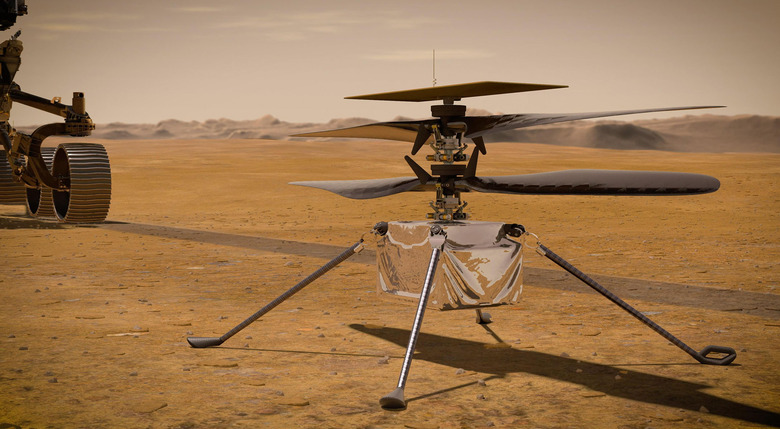NASA's Mars Helicopter Just Flew For The Second Time
When NASA's Ingenuity helicopter took off for the first time on Mars on April 19th it was a history-making moment. No manmade spacecraft had ever achieved powered flight on another planet, and the pint-sized helicopter made it look relatively easy. Such a monumental occasion is surely worthy of some moment of reflection on behalf of NASA and the scientific community at large, but NASA didn't have any time to waste. Instead, it went ahead and broke Ingenuity's own record today, just a few days after the helicopter's maiden flight.
In a new blog post, NASA's Jet Propulsion Laboratory reveals that the helicopter completed its second flight today, April 22nd, and it did so while extending the amount of time it remained in the air and also completed a couple of simple maneuvers as a bonus. It's unclear exactly how many flights NASA will attempt within the helicopter's one-month lifespan but with two already under its belt, the sky is the limit.
According to the Jet Propulsion Laboratory, the helicopter took off in the early morning hours (Eastern time) and went a bit higher than the first. The aircraft topped out at 16 feet of altitude, compared to the first flight which reached 10 feet. The helicopter reached its target altitude and then tilted roughly five degrees. This gave the craft some horizontal movement and Ingenuity traveled approximately seven feet sideways before once again righting itself.
"The helicopter came to a stop, hovered in place, and made turns to point its camera in different directions," Håvard Grip, Ingenuity's chief pilot at JPL, said in a statement. "Then it headed back to the center of the airfield to land. It sounds simple, but there are many unknowns regarding how to fly a helicopter on Mars. That's why we're here – to make these unknowns known."
These might sound like rather simple tasks for a helicopter, especially since drone technology has reached a point where you can spend $100 and get one that is capable of some seriously crazy maneuvers. However, building, testing, and eventually flying one of these crafts on Mars is a great deal more complicated. Real-time control just isn't possible due to the severe delay in communication, and the atmosphere of Mars is a whole lot different than that of Earth, changing the makeup of aerial maneuvers.
NASA will have a few more weeks of life left in Ingenuity before it decides to call it quits, and during that time it hopes to perform several more flights. The helicopter's handlers may choose to make each successive flight more and more complicated, but Ingenuity's mission has no scientific objectives whatsoever. As a proof of concept, the aircraft's only job is to do what it's told and hopefully survive to send data back to Earth.
